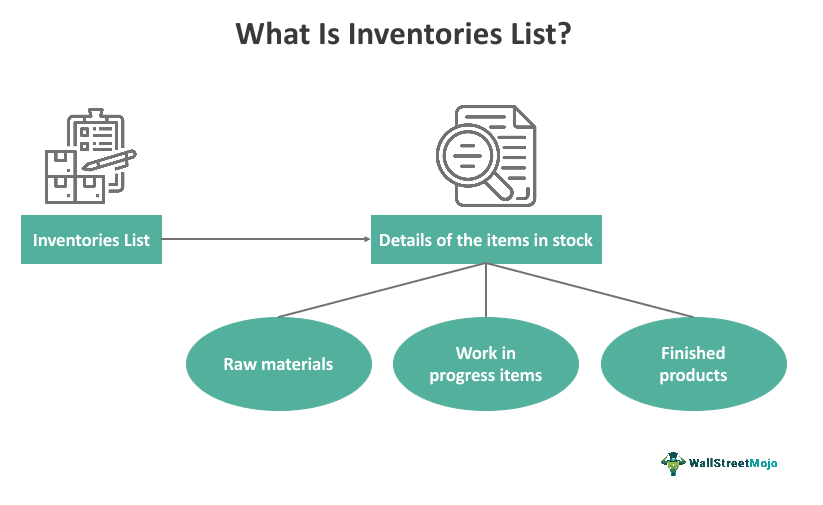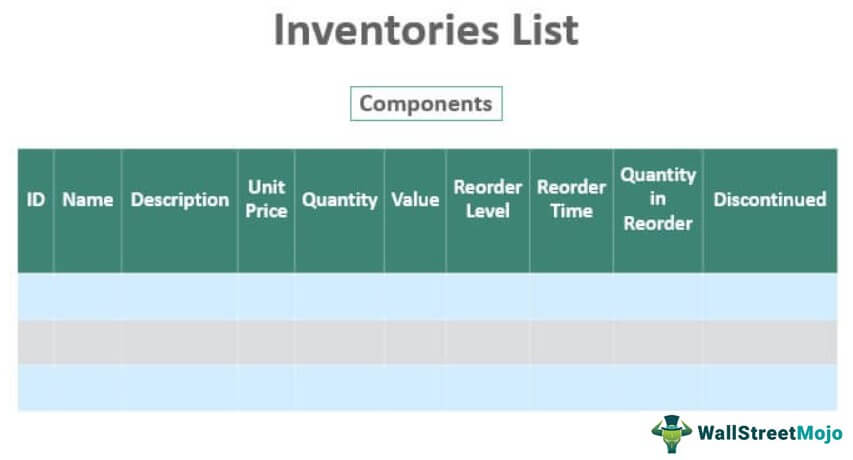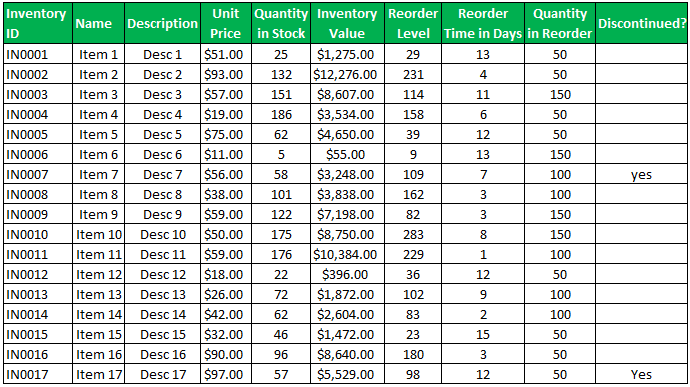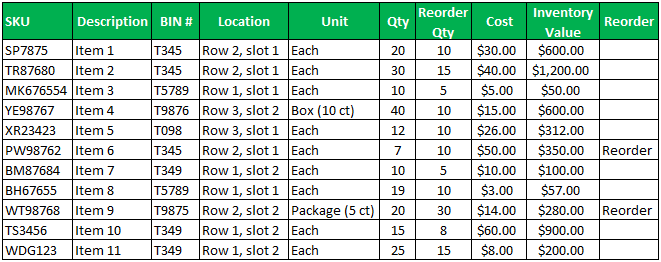Inventory List Meaning
An inventory list is a way to gain more control over the business inventory so that the utilization of the inventory can be done in an efficient manner, where the list contains the details regarding opening stock, purchases, closing stock, etc. of all the types of inventories used by the company.

You are free to use this image on your website, templates, etc, Please provide us with an attribution linkHow to Provide Attribution?Article Link to be Hyperlinked
For eg:
Source: Inventories List (wallstreetmojo.com)
With the help of the inventory list, the firms remain aware of the number of items that are already supplied, assess the quantities with respect to market demands, track the flow of items, estimate the sales figures, etc. It also helps businesses learn about the time when they should place an order for the next set of goods when the available stocks are almost over. Plus, businesses can also identify and specify the items that have been discontinued.
Table of contents
Inventory List Explained
An inventory list is a mechanism to exercise more control over the inventory of a business entity so that the inventories can be utilized efficiently. It is usually made in an orderly fashion where it is represented as a list of stock items with details about each line item. Nowadays, most inventory management is done through computer software which makes such data-intensive tasks bearable.
The inventory list is updated at variable frequencies depending on the inventory flow or turnaround time of the inventory, depending on the type of business. So if the business entity deals with fast-moving items, then the inventory list needs to be updated daily. On the other hand, if the inventory push-out is sluggish, it may be updated weekly or monthly.
The amount of stock or inventory necessary to carry on the business activities depends on the nature and size of the business. It also depends on whether or not the business entity has enough space to store the inventory items, or else it would have to ask the supplier to store them at its site in exchange for some fee. Keeping a low inventory level has advantages like lower storage cost, lesser stock wastage, easy updating stock with the latest products, etc., and disadvantages like loss of business opportunity, dependence on supplier’s efficiency, etc.
Similarly, a high inventory level has its share of advantages like easy maintenance, always ready to serve clients, lesser average inventoryAverage InventoryAverage Inventory is the mean of opening and closing inventory of a particular period. It helps the management to understand the inventory that a business needs to hold during its daily course of business.read more cost due to bulk buying, etc., and disadvantages like higher capital tied up, more wastage of inventory, costlier to update inventory, etc. So it all depends on the company’s management policy and flow of inventory as well.
Accounting for Financial Analyst (16+ Hours Video Series)
–>> p.s. – Want to take your financial analysis to the next level? Consider our “Accounting for Financial Analyst” course, featuring in-depth case studies of McDonald’s and Colgate, and over 16 hours of video tutorials. Sharpen your skills and gain valuable insights to make smarter investment decisions.
Components
Though there is no exact format for an inventoryFormat For An InventoryExcel can assist in creating an inventory template that simplifies inventory management. It is extremely beneficial to large-scale retailers who deal with bulk orders.read more list, the following could be regarded as components of the inventories list on a generic basis.
Let us look at the elements below that help form the basis for any inventory list template, thereby making these lists organized and easily readable.

You are free to use this image on your website, templates, etc, Please provide us with an attribution linkHow to Provide Attribution?Article Link to be Hyperlinked
For eg:
Source: Inventories List (wallstreetmojo.com)
#1- Inventory ID
Usually, this serves as an inventory identifier in the inventory controlInventory ControlInventory control is adopted by organizations to properly manage the inventory/stock stored in the course of business to minimize storage & carrying charges for the inventory and satisfy its customer’s demands in the market.read more to track the status of a particular item in the list.
#2- Name
It represents the name of the item on the list to represent the item.
#3- Description
It represents the detail of the description of the item. It may tell about some item specifications that may help identify a particular inventory item amongst so many of them, or it may be some general description.
#4- Unit Price
It is the purchase price of the item on a per-unit basis. Sometimes, if the item is purchased in different slots at different prices, it may represent the average unit priceAverage Unit PriceUnit Price is a measurement used for indicating the price of particular goods or services to be exchanged with customers or consumers for money. It includes fixed costs, variable costs, overheads, direct labour, and a profit margin for the organization.read more of the item as well.
#5- Quantity
Here goes the total number of units of the particular item on the list. It gives an idea of whether an order to replenish the inventory must be placed with the vendor or not. Every business entity has some threshold to
#6- Value
This column is of high importance as it represents the value of the inventory item for all the units present in the warehouse. It also represents a type of budgeting to glimpse how much money is tied up in inventories.
#7- Reorder Level
It depicts the threshold level for each line item on the list. When the inventory quantity goes below the reorder level, the order is automatically placed with the vendor if the inventory management system is in place in the business entity.
#8- Reorder Time (in days)
It is the expected time between placing the order of a particular inventory item with the vendor and receiving the ordered item.
#9- Quantity in Reorder
It refers to the quantity for which the replenishment order must be placed with the vendor. This amount puts back the total quantity to the fulfillment level, above the reorder pointReorder PointReorder point refers to that stage of inventory management in which the inventory needs to be reordered to ensure the timely availability of goods for sales. It ensures that a business can have a minimum product quantity in storage to prevent operational disruptions arising out of a stockout. At the same time, the reorder point will stop holding stock beyond the safety point to avoid unnecessary storage costs.read more.
#10- Discontinued
This column mentions whether the particular item is no longer maintained as an inventory.
How To Make?
Creating a stock inventory list is simple and easy. While in earlier days, a manual list or register was maintained to keep track, today, businesses prefer Excel or other spreadsheets to build the inventory list template to record stock-related data.
Though it is simple to maintain this list in Excel, following a proper sequence of how to create it, is a must. Let us have a quick look at the steps below to make an inventory list in Excel or other spreadsheets:
- The first thing is to open a spreadsheet if one wants to have the list prepared. It can be an Excel sheet, Google sheet, etc.
- If the spreadsheet is to be used by more than one person, setting the required permissions is the second step.
- The third step is to arrange the columns and name or label them. Sorting this step helps categorize the products properly that are to be recorded. There are headers available in the form of inbuilt templates of the spreadsheets. Some of the widely used column names include – item name, unit price, number in stock, sales price, order time, supplier name, discontinued item, etc.
- Based on the product category or labeled columns, users can enter the details of the inventory.
Save the data once all details are entered.
Examples
Let us consider the following examples to understand what is an inventory list and how it helps a firm maintain and record available stock:
Example #1

Example #2

Recommended Articles
This article has been a guide to Inventories List and its meaning. Here, we explain the concept with examples and also discuss the steps of how to make it. You may learn more about Accounting from the following articles –

